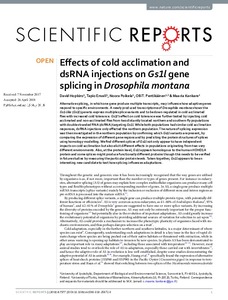Effects of cold acclimation and dsRNA injections on Gs1l gene splicing in Drosophila montana
Kankare M; Hopkins D; Pentikäinen OT; Poikela N; Envall T
Effects of cold acclimation and dsRNA injections on Gs1l gene splicing in Drosophila montana
Kankare M
Hopkins D
Pentikäinen OT
Poikela N
Envall T
NATURE PUBLISHING GROUP
Julkaisun pysyvä osoite on:
https://urn.fi/URN:NBN:fi-fe2021042719226
https://urn.fi/URN:NBN:fi-fe2021042719226
Tiivistelmä
Alternative splicing, in which one gene produce multiple transcripts, may influence how adaptive genes respond to specific environments. A newly produced transcriptome of Drosophila montana shows the Gs1-like (Gs1l) gene to express multiple splice variants and to be down regulated in cold acclimated flies with increased cold tolerance. Gs1l's effect on cold tolerance was further tested by injecting cold acclimated and non-acclimated flies from two distantly located northern and southern fly populations with double stranded RNA (dsRNA) targeting Gs1l. While both populations had similar cold acclimation responses, dsRNA injections only effected the northern population. The nature of splicing expression was then investigated in the northern population by confirming which Gs1l variants are present, by comparing the expression of different gene regions and by predicting the protein structures of splices using homology modelling. We find different splices of Gs1l not only appear to have independent impacts on cold acclimation but also elicit different effects in populations originating from two very different environments. Also, at the protein level, Gs1l appears homologous to the human HDHD1A protein and some splices might produce functionally different proteins though this needs to be verified in future studies by measuring the particular protein levels. Taken together, Gs1l appears to be an interesting new candidate to test how splicing influences adaptations.
Kokoelmat
- Rinnakkaistallenteet [19207]
